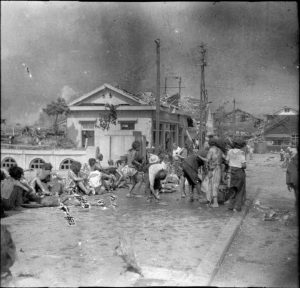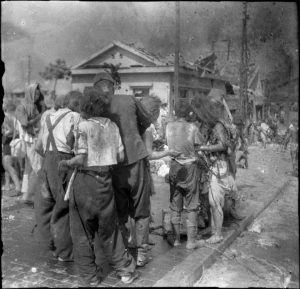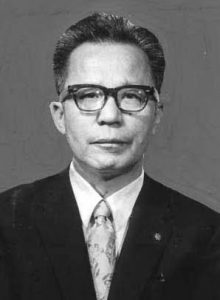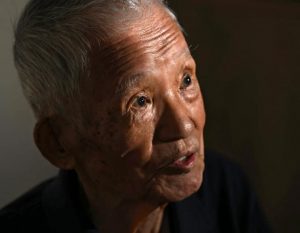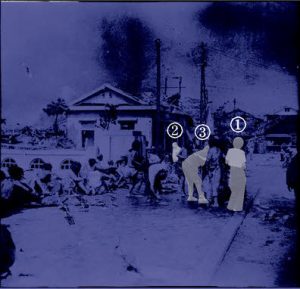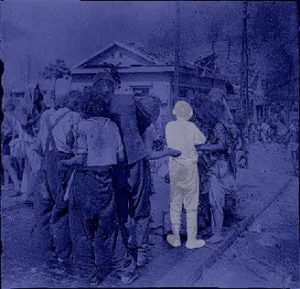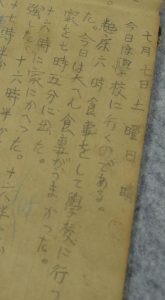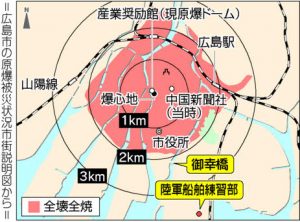Documenting Hiroshima of 1945: 79 years ago today, at one end of Miyuki Bridge
Aug. 6, 2024
by Kyosuke Mizukawa, Senior Staff Writer
On August 6, 1945, the U.S. military detonated a single atomic bomb in the sky above Hiroshima. What scenes played out under the huge “mushroom cloud” generated by the bombing? Two photographs taken at the west end of Miyuki Bridge (in Hiroshima’s present-day Naka Ward), where many wounded A-bomb victims had sought refuge, record in detail the devastating situation of citizens in the central area of Hiroshima on the day of the atomic bombing. Yoshito Matsushige, a staff photographer at the Chugoku Shimbun who died in 2005 at the age of 92, took the two photos after struggling with his own emotions. Along with some of the “voices” from those who were there at the time, the Chugoku Shimbun looks back at this day 79 years ago.
Through tears and after much struggle, Mr. Matsushige took photos of people in agony
“It was a flash, as if lightning had struck right in front of me,” recalled Mr. Matsushige in a testimonial video of that day, August 6, produced by the Hiroshima Peace Culture Foundation and recorded in 1986. At the time of the bombing, he was 32 years old and a staff photographer at the Chugoku Shimbun. He had returned home after first leaving for work because he needed to use the restroom. Suddenly, a flash appeared before his eyes, and he was slammed against a wall by the A-bomb’s blast.
He was around 2.8 kilometers southeast of what was later learned to be the hypocenter. He crossed the nearby Miyuki Bridge in an attempt to head toward the central part of Hiroshima, where the newspaper’s head office was located. He turned back along the way, however, after witnessing the strong force of the fires that had arisen.
After returning to the west end of Miyuki Bridge, he witnessed a crowd of wounded people moaning and crying, with severely burned hair and skin. That spot was around 2.2 kilometers from the hypocenter. Mr. Matsushige said in his videotaped testimony, “I saw a young mother running around with a small child in her arms shouting, ‘Open your eyes, please.’ It was truly hell.”
Himself suffering only minor injuries Mr. Matsushige felt sorry for aiming his camera at those in agony who were on the verge of death. After some hesitation, he made the decision to carry out his job as a photographer.
“I took one photo at first, saying to myself, ‘What a terrible thing they did.’ When I pressed the shutter for the second shot with anger and sorrow in mind, my tears clouded the viewfinder.” That is an excerpt from an account he wrote for an anthology of photographs titled The First Atomic Bomb Photographic Record of Hiroshima, published in 1952. In a different account published in 1970, he wrote that he snapped the shutter with a feeling of apology to the suffering victims — “Please forgive me.”
The two photos depicting people at Miyuki Bridge were taken between around 9:30 and 11 a.m. In the afternoon that day, sensing that the force of the fires had abated, Mr. Matsushige entered central Hiroshima. In the area of Kamiya-cho (now part of the city’s Naka Ward), located about 200 meters from the hypocenter, he saw naked bodies lying piled on top of one another inside an incinerated streetcar. According to Mr. Matsushige, while walking in the center of the city, he was unable to take a single photo. He explained in his testimony he could not do so because the image of the dead bodies was simply “too sad and cruel.”
With burns on his face, Seigo Nishioka flees with the hope, “I want to go home”
“I was in total confusion. My only thought was ‘I want to go home.’ The central part of the city was engulfed in flames. I saw many bodies floating on the river.”
Those words were spoken by Seigo Nishioka, 92, an A-bomb survivor living in Hatsukaichi City, Hiroshima Prefecture, who was 13 at the time of the bombing. Mr. Nishioka had fled to the area near Senda Police Station, a building that was captured in the center of Mr. Matsushige’s first photo. At the time, Mr. Nishioka was a first-year student at Hiroshima Prefectural Technical High School. His classmates had been mobilized for building-demolition work to create fire lanes in the area of Nakajima-shinmachi (in the city’s present-day Naka Ward), about 600 meters from the hypocenter, but he had been assigned to do other tasks at school since he was not feeling well.
The school, near Miyuki Bridge, was located about two kilometers from the hypocenter. Upon entering the school grounds through the front gate, he said, “I felt heat as if I had been thrown into a fire, and I cringed.” He was then blown down by the bomb’s blast and trapped under a pillar of the collapsed wooden school building.
He was rescued by others but had suffered burns to the left side of his face. As he walked, he noticed a sound made by the blood from his injured left foot that had filled his shoe. He walked with arms around the shoulders of two upper-classmates, managing to arrive at the area near Senda Police Station. A faint voice called out to him, “Hey… .” When he looked in that direction, there was a different upper-classmate lying on the ground naked to the waist with terrible burns.
Mr. Nishioka’s home was located in the area of Nishihakushima-cho (now part of Hiroshima’s Naka Ward), a location isolated by the fierce fires. Amid feelings of anxiety and uncertainty, he caught a glimpse of Yoshito Matsushige holding his camera. “Some were saying, ‘He must be a spy.’ He left the scene with a panicked and sad expression.”
Mr. Nishioka was later taken to a relief station in the village of Saka (present-day Saka-cho in Hiroshima Prefecture) and narrowly escaped death. All of his classmates at school had been killed as they engaged in building demolition. His childhood friend, Tomoko Yanagawa, then a first-year student at Hiroshima Prefectural First Girls’ High School (Prefectural Girls’ School; present-day Minami High School), also died after being mobilized for building-demolition work.
There is no existing photo taken nearer to the hypocenter than those taken at the west end of Miyuki Bridge on August 6, 1945. Mr. Nishioka continually thinks of the countless lives lost that day, wondering how hot they must have felt and how much they must have suffered.
Survivors captured in photos: “Waves of wounded, screaming and crying students…”
Who are the A-bomb survivors captured in the photos taken at the west end of Miyuki Bridge? In the following section, we will introduce some of the claims and related testimonies made by the survivors themselves and their families after the war.
Person number 1., Mitsuko Kochi (who died in 2018), came forward while she was still alive to claim it was she in the photo. Ms. Kochi was a second-year student at Hiroshima Girls’ Commercial School (now Hiroshima Shoyo High School) at the time, and experienced the atomic bombing at a branch office of the Hiroshima Chokin Bank, where she had been mobilized to work about 1.6 kilometers from the hypocenter. She fled with her father, who suffered terrible burns while working in the vicinity, as well as her classmates.
“When I tugged on his hand, the skin on his right arm peeled right off. In shock, I held his unburnt left hand and together we fled,” Ms. Kochi explained in a testimonial video recorded by Hiroshima Peace Culture Foundation in 2010.
Person no. 2. was identified as the physician Yasutaro Matsubayashi (who died in 1961), by his surviving family in a 2021 interview with the Chugoku Shimbun, confirming that “from a family perspective, there is no doubt.” Mr. Matsubayashi had crawled out from under the collapsed home that doubled as his medical clinic and treated the wounded despite his own arm injuries. In a personal account, he wrote that he could not forget one student who looked to be a first-year junior high school student and had experienced the atomic bombing while working at the dismantling of buildings as a mobilized student.
An excerpt from Mr. Matsubayashi’s personal notes collected in the Atomic Bomb Diary, published in 1970, described the situation as, “(The student) complained of pain with burns and sores over the entire body, crying out, ‘I said I would take today off, but my mother forced me to come, and then I met with this misfortune.”.
Person no. 3. is considered to be Katsuyuki Fujikawa (who died in 2001). He was 29 years old at the time and a police officer at Ujina Police Station. Mr. Fujikawa helped the wounded by applying oil to their burns.
“A wave of wounded survivors came our way, crying ‘Help us’ … Some collapsed on the spot and did not move again. I could do absolutely nothing to help them,” was how Mr. Fujikawa described the situation in personal notes appearing in Memoirs of the Atomic Bombing, published in 1989.
Young boy with his back turned to the camera is Akira Kutsuki, whose remains were never found, according to testimonies of family and others
Mr. Matsushige’s second photo taken at the west end of Miyuki Bridge includes a shot of the back of a boy with big ears. The surviving family and classmates of Akira Kutsuki, 12 at the time, have concluded that the boy in the photo was Akira. Mr. Kutsuki’s remains were never found after the bombing.
At the time, Akira was a first-year student at Hiroshima Municipal Junior High School (present-day Motomachi High School) and had been mobilized to work on the demolition of buildings to create fire lanes in the area of Koami-cho (now part of Naka Ward). After saying to his family “I’m leaving” as he departed their home in the area of Danbarasuehiro-cho (now part of Minami Ward), the atomic bomb detonated. Although his family desperately searched for him at relief stations, they were unable to find him, and he remained missing.
Twenty-three years later, the late Hisa Kutsuki, Akira’s mother, ran into this photo in a book she had been reading. She said, “Akira is here.” Akira’s father, the late Yoshiyuki Kutsuki, was also convinced it was his son. In his personal notes titled Shinnyo no tsuki yadoru (in English, ‘There was spiritual enlightenment’) written in 1977, Yoshiyuki wrote, “I looked at the photo many times and tightly embraced it, realizing how cute he was and imagining ... how much my poor son must have wanted to come home and struggled to flee.” He placed the photo in front of their Buddhist altar at home.
“I am sure that’s Akira,” Shunichiro Arai, 92, and Isamu Takata, 92, two A-bomb survivors who both live in Hiroshima’s Minami Ward, said assuredly after gazing at the boy in the photo. Mr. Kutsuki and the two had been in the same year at the National School attached to Hiroshima Normal School’s Boy’s Division (present-day Shinonome Elementary School Attached to Hiroshima University).
Mr. Takata said, “The decisive factors were his ears and the slight slouch.” Mr. Arai reminisced about the boy. “One day, Akira proudly brought to school a fragment he had picked up of an anti-aircraft artillery’s exploded bullet. We were all excited and said to him, ‘You’ll get in trouble!’”
Details about the end of Mr. Kutsuki’s life are still unknown. As the A-bomb survivor appointed by the Hiroshima Peace Memorial Museum to communicate his experience in the atomic bombing, Mr. Arai has conveyed information about the deaths of many boys and girls in the atomic bombing. He expressed his hope. “I want young people to look at the photo and think, ‘what if the boy in the photo had been me’.”
(Originally published on August 6, 2024)
On August 6, 1945, the U.S. military detonated a single atomic bomb in the sky above Hiroshima. What scenes played out under the huge “mushroom cloud” generated by the bombing? Two photographs taken at the west end of Miyuki Bridge (in Hiroshima’s present-day Naka Ward), where many wounded A-bomb victims had sought refuge, record in detail the devastating situation of citizens in the central area of Hiroshima on the day of the atomic bombing. Yoshito Matsushige, a staff photographer at the Chugoku Shimbun who died in 2005 at the age of 92, took the two photos after struggling with his own emotions. Along with some of the “voices” from those who were there at the time, the Chugoku Shimbun looks back at this day 79 years ago.
Through tears and after much struggle, Mr. Matsushige took photos of people in agony
“It was a flash, as if lightning had struck right in front of me,” recalled Mr. Matsushige in a testimonial video of that day, August 6, produced by the Hiroshima Peace Culture Foundation and recorded in 1986. At the time of the bombing, he was 32 years old and a staff photographer at the Chugoku Shimbun. He had returned home after first leaving for work because he needed to use the restroom. Suddenly, a flash appeared before his eyes, and he was slammed against a wall by the A-bomb’s blast.
He was around 2.8 kilometers southeast of what was later learned to be the hypocenter. He crossed the nearby Miyuki Bridge in an attempt to head toward the central part of Hiroshima, where the newspaper’s head office was located. He turned back along the way, however, after witnessing the strong force of the fires that had arisen.
After returning to the west end of Miyuki Bridge, he witnessed a crowd of wounded people moaning and crying, with severely burned hair and skin. That spot was around 2.2 kilometers from the hypocenter. Mr. Matsushige said in his videotaped testimony, “I saw a young mother running around with a small child in her arms shouting, ‘Open your eyes, please.’ It was truly hell.”
Himself suffering only minor injuries Mr. Matsushige felt sorry for aiming his camera at those in agony who were on the verge of death. After some hesitation, he made the decision to carry out his job as a photographer.
“I took one photo at first, saying to myself, ‘What a terrible thing they did.’ When I pressed the shutter for the second shot with anger and sorrow in mind, my tears clouded the viewfinder.” That is an excerpt from an account he wrote for an anthology of photographs titled The First Atomic Bomb Photographic Record of Hiroshima, published in 1952. In a different account published in 1970, he wrote that he snapped the shutter with a feeling of apology to the suffering victims — “Please forgive me.”
The two photos depicting people at Miyuki Bridge were taken between around 9:30 and 11 a.m. In the afternoon that day, sensing that the force of the fires had abated, Mr. Matsushige entered central Hiroshima. In the area of Kamiya-cho (now part of the city’s Naka Ward), located about 200 meters from the hypocenter, he saw naked bodies lying piled on top of one another inside an incinerated streetcar. According to Mr. Matsushige, while walking in the center of the city, he was unable to take a single photo. He explained in his testimony he could not do so because the image of the dead bodies was simply “too sad and cruel.”
With burns on his face, Seigo Nishioka flees with the hope, “I want to go home”
“I was in total confusion. My only thought was ‘I want to go home.’ The central part of the city was engulfed in flames. I saw many bodies floating on the river.”
Those words were spoken by Seigo Nishioka, 92, an A-bomb survivor living in Hatsukaichi City, Hiroshima Prefecture, who was 13 at the time of the bombing. Mr. Nishioka had fled to the area near Senda Police Station, a building that was captured in the center of Mr. Matsushige’s first photo. At the time, Mr. Nishioka was a first-year student at Hiroshima Prefectural Technical High School. His classmates had been mobilized for building-demolition work to create fire lanes in the area of Nakajima-shinmachi (in the city’s present-day Naka Ward), about 600 meters from the hypocenter, but he had been assigned to do other tasks at school since he was not feeling well.
The school, near Miyuki Bridge, was located about two kilometers from the hypocenter. Upon entering the school grounds through the front gate, he said, “I felt heat as if I had been thrown into a fire, and I cringed.” He was then blown down by the bomb’s blast and trapped under a pillar of the collapsed wooden school building.
He was rescued by others but had suffered burns to the left side of his face. As he walked, he noticed a sound made by the blood from his injured left foot that had filled his shoe. He walked with arms around the shoulders of two upper-classmates, managing to arrive at the area near Senda Police Station. A faint voice called out to him, “Hey… .” When he looked in that direction, there was a different upper-classmate lying on the ground naked to the waist with terrible burns.
Mr. Nishioka’s home was located in the area of Nishihakushima-cho (now part of Hiroshima’s Naka Ward), a location isolated by the fierce fires. Amid feelings of anxiety and uncertainty, he caught a glimpse of Yoshito Matsushige holding his camera. “Some were saying, ‘He must be a spy.’ He left the scene with a panicked and sad expression.”
Mr. Nishioka was later taken to a relief station in the village of Saka (present-day Saka-cho in Hiroshima Prefecture) and narrowly escaped death. All of his classmates at school had been killed as they engaged in building demolition. His childhood friend, Tomoko Yanagawa, then a first-year student at Hiroshima Prefectural First Girls’ High School (Prefectural Girls’ School; present-day Minami High School), also died after being mobilized for building-demolition work.
There is no existing photo taken nearer to the hypocenter than those taken at the west end of Miyuki Bridge on August 6, 1945. Mr. Nishioka continually thinks of the countless lives lost that day, wondering how hot they must have felt and how much they must have suffered.
Survivors captured in photos: “Waves of wounded, screaming and crying students…”
Who are the A-bomb survivors captured in the photos taken at the west end of Miyuki Bridge? In the following section, we will introduce some of the claims and related testimonies made by the survivors themselves and their families after the war.
Person number 1., Mitsuko Kochi (who died in 2018), came forward while she was still alive to claim it was she in the photo. Ms. Kochi was a second-year student at Hiroshima Girls’ Commercial School (now Hiroshima Shoyo High School) at the time, and experienced the atomic bombing at a branch office of the Hiroshima Chokin Bank, where she had been mobilized to work about 1.6 kilometers from the hypocenter. She fled with her father, who suffered terrible burns while working in the vicinity, as well as her classmates.
“When I tugged on his hand, the skin on his right arm peeled right off. In shock, I held his unburnt left hand and together we fled,” Ms. Kochi explained in a testimonial video recorded by Hiroshima Peace Culture Foundation in 2010.
Person no. 2. was identified as the physician Yasutaro Matsubayashi (who died in 1961), by his surviving family in a 2021 interview with the Chugoku Shimbun, confirming that “from a family perspective, there is no doubt.” Mr. Matsubayashi had crawled out from under the collapsed home that doubled as his medical clinic and treated the wounded despite his own arm injuries. In a personal account, he wrote that he could not forget one student who looked to be a first-year junior high school student and had experienced the atomic bombing while working at the dismantling of buildings as a mobilized student.
An excerpt from Mr. Matsubayashi’s personal notes collected in the Atomic Bomb Diary, published in 1970, described the situation as, “(The student) complained of pain with burns and sores over the entire body, crying out, ‘I said I would take today off, but my mother forced me to come, and then I met with this misfortune.”.
Person no. 3. is considered to be Katsuyuki Fujikawa (who died in 2001). He was 29 years old at the time and a police officer at Ujina Police Station. Mr. Fujikawa helped the wounded by applying oil to their burns.
“A wave of wounded survivors came our way, crying ‘Help us’ … Some collapsed on the spot and did not move again. I could do absolutely nothing to help them,” was how Mr. Fujikawa described the situation in personal notes appearing in Memoirs of the Atomic Bombing, published in 1989.
Young boy with his back turned to the camera is Akira Kutsuki, whose remains were never found, according to testimonies of family and others
Mr. Matsushige’s second photo taken at the west end of Miyuki Bridge includes a shot of the back of a boy with big ears. The surviving family and classmates of Akira Kutsuki, 12 at the time, have concluded that the boy in the photo was Akira. Mr. Kutsuki’s remains were never found after the bombing.
At the time, Akira was a first-year student at Hiroshima Municipal Junior High School (present-day Motomachi High School) and had been mobilized to work on the demolition of buildings to create fire lanes in the area of Koami-cho (now part of Naka Ward). After saying to his family “I’m leaving” as he departed their home in the area of Danbarasuehiro-cho (now part of Minami Ward), the atomic bomb detonated. Although his family desperately searched for him at relief stations, they were unable to find him, and he remained missing.
Twenty-three years later, the late Hisa Kutsuki, Akira’s mother, ran into this photo in a book she had been reading. She said, “Akira is here.” Akira’s father, the late Yoshiyuki Kutsuki, was also convinced it was his son. In his personal notes titled Shinnyo no tsuki yadoru (in English, ‘There was spiritual enlightenment’) written in 1977, Yoshiyuki wrote, “I looked at the photo many times and tightly embraced it, realizing how cute he was and imagining ... how much my poor son must have wanted to come home and struggled to flee.” He placed the photo in front of their Buddhist altar at home.
“I am sure that’s Akira,” Shunichiro Arai, 92, and Isamu Takata, 92, two A-bomb survivors who both live in Hiroshima’s Minami Ward, said assuredly after gazing at the boy in the photo. Mr. Kutsuki and the two had been in the same year at the National School attached to Hiroshima Normal School’s Boy’s Division (present-day Shinonome Elementary School Attached to Hiroshima University).
Mr. Takata said, “The decisive factors were his ears and the slight slouch.” Mr. Arai reminisced about the boy. “One day, Akira proudly brought to school a fragment he had picked up of an anti-aircraft artillery’s exploded bullet. We were all excited and said to him, ‘You’ll get in trouble!’”
Details about the end of Mr. Kutsuki’s life are still unknown. As the A-bomb survivor appointed by the Hiroshima Peace Memorial Museum to communicate his experience in the atomic bombing, Mr. Arai has conveyed information about the deaths of many boys and girls in the atomic bombing. He expressed his hope. “I want young people to look at the photo and think, ‘what if the boy in the photo had been me’.”
(Originally published on August 6, 2024)

